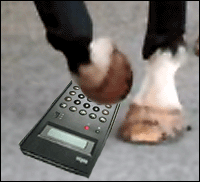Clever Hans
Created | Updated Jan 23, 2012

The story of Clever Hans is often repeated as a warning that we should always carefully investigate extraordinary claims. Although his name sounds like the protagonist of a moralistic Grimm fairy tale, Clever Hans (or Kluge Hans as he is often called) was an apparently psychic Russian horse.
Kluge Hans the Horse
Hans was an Arabian stallion purchased in 1888 by Wilhelm Von Osten. Sometimes described as a retired school teacher and sometimes as a Russian aristocrat, Von Osten considered himself a particularly gifted educator and was convinced that animals possessed an intelligence equal to that of man. To prove his point, he started by trying to teach a cat, a horse and even a bear how to do simple arithmetic. Von Osten had no luck with the cat or the bear, but Hans was a different matter.
Von Osten's method was quite elementary. He began by demonstrating counting to Hans, using spoken words in the company of objects. After a time Von Osten dispensed with objects and simply used numerals on a blackboard. Hans concentrated intently on his task, tapping numbers out with his hoof. By the end of his schooling, Hans could tap out correct answers for questions ranging from addition, simple square roots and even the names of people he knew by tapping out letters in a simple code. Hans could also tell the time when asked. A great many investigators, including a special commission of thirteen people of varied background in 1904 led by Carl Stumpf, director of the Berlin Psychological Institute, were absolutely convinced of the startling intelligence of Hans the horse. Even if Von Osten was absent, Hans would still come up with the correct answers.
The Big Disappointment
Stumpf's commission was followed up by a very carefully planned investigation conducted by Oskar Pfungst. Pfungst began his testing of Hans by using numbered flash cards with which Hans was already familiar. Pfungst controlled the situation very carefully: first, Von Osten was allowed to see each number before Hans did - and Hans continued to be very clever. Then Pfungst instructed Von Osten to show Hans the cards without looking at them. Suddenly Hans's answers became random. What happened?
Pfungst concluded that somehow Von Osten, when he knew the answer, was giving it to Hans. This hypothesis was confirmed when Pfungst had Von Osten stand behind Hans and ask him to count. Again, the horse was stumped. Somehow, Hans was figuring out the correct answer by looking at the interrogator.
Next, Pfungst turned to Von Osten and watched the teacher's behaviour. Through careful observation, Pfungst was able to create a sort of dictionary of Von Osten's unconscious physical cues that were being read by Hans. Von Osten, or any other interrogator of Hans, would subtly change posture as Hans's tapping was expected to start and would change again as Hans approached the correct answer. Pfungst gave the final demonstration of the accuracy of his conclusions by cueing Hans to count without speaking, and to provide answers to questions not asked.
Conclusion? Clever Hans was a clever horse, but he was not a mathematician.
Pfungst published his findings in book form as Clever Hans: The Horse of Mr Von Osten in 1907, with the first English translation being published in 1911.
Further Reading
Ivan Pavlov, famous for the 'Pavlov's Dog' experiment

